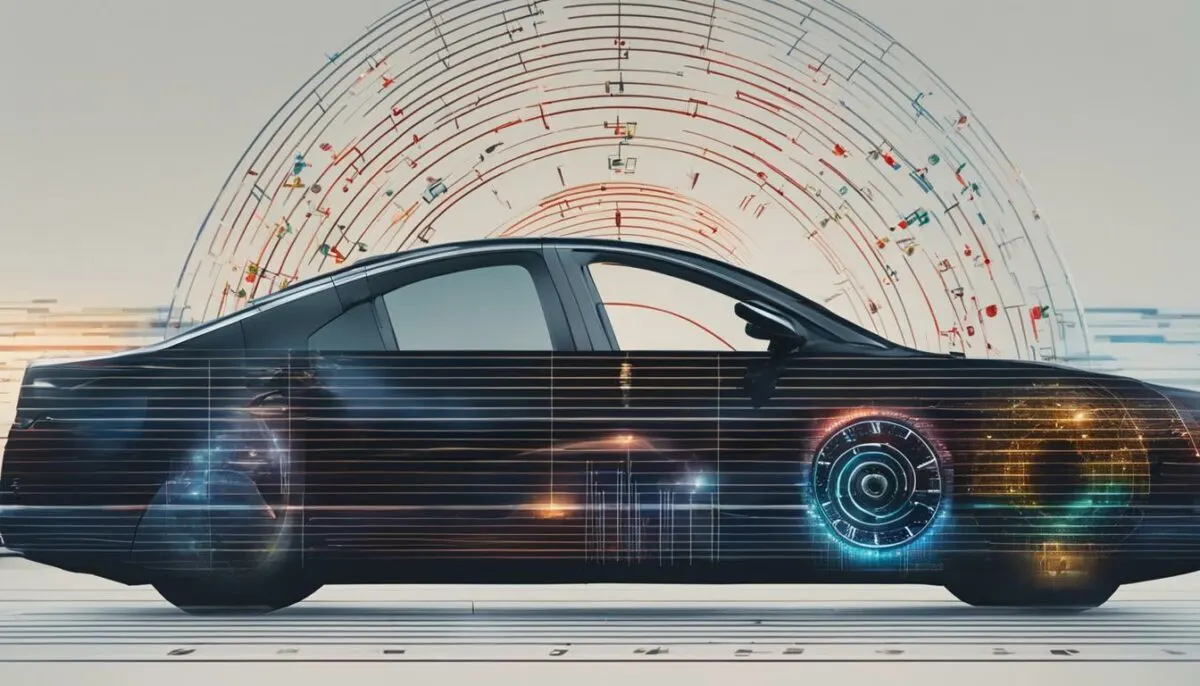If you’re an audiophile who loves to have high-quality sound in your car, you might have heard of time alignment in car audio. This technique has gained immense popularity among car enthusiasts, and for a good reason. By correcting the arrival time of sound from various speakers to reach the listener’s ears simultaneously, time alignment ensures a balanced and immersive soundstage, eliminating any delays or phase distortions.
In this comprehensive guide, we’ll delve into the concept of time alignment in car audio systems. You’ll discover how it can significantly enhance your sound quality and improve your overall driving experience. Whether you’re a novice or an expert, this guide will provide you with the knowledge and skills required to achieve the perfect time alignment in your car audio system.
Key Takeaways
- Time alignment refers to the process of correcting the arrival time of sound from various speakers to reach the listener’s ears simultaneously.
- Time alignment ensures a balanced and immersive soundstage, eliminating any delays or phase distortions.
- Time alignment plays a critical role in optimizing sound quality in car audio systems.
- There are multiple ways to achieve time alignment in car audio.
- Achieving the perfect time alignment requires careful calibration and fine-tuning.
The Basics of Time Alignment in Car Audio
Have you ever experienced a sound that seemed to come from all directions while driving? It could be because of time alignment in your car audio system. Time alignment is the process of correcting the arrival time of sound from various speakers to reach the listener’s ears simultaneously.
This synchronization ensures a more balanced and immersive soundstage, eliminating any delays or phase distortions. The result? A more enjoyable and realistic listening experience. So, what is time alignment car audio?
The Concept of Time Alignment Car Audio
Time alignment in car audio refers to the process of synchronizing the soundwaves from different speakers to produce sound that arrives at the listener’s ears simultaneously. This results in a more balanced and natural listening experience with a clear and detailed sound, free from phase distortion and delay.
For instance, imagine you are listening to a song and the vocalist’s voice seems to be coming from the opposite side of the car. This could be because of a speaker located far from the listener’s ears. Time alignment corrects this by adjusting the time delay between speakers to ensure that the sound waves from all speakers arrive at the same time at the listener’s ears.
The Benefits of Time Alignment Car Audio
Proper time alignment in your car audio system can unlock numerous benefits, including:
- Reduced phase distortion
- Improved sound imaging and localization
- Clear and detailed sound quality
- Minimized listener fatigue
- More immersive listening experience
By correcting the arrival time of sound waves from various speakers, time alignment in your car audio system can significantly enhance your listening experience and allow you to enjoy your favorite music like never before.
How to Achieve Time Alignment in Car Audio
There are several ways to achieve time alignment in your car audio system. One common method is through digital signal processors (DSP), which allow you to adjust the time delay for each speaker independently. This can be achieved through software or dedicated processors.
Manual adjustments can also be made by physically positioning the speakers and adjusting the delay settings. This method is less precise than using a digital signal processor but can still achieve a satisfactory level of time alignment.
The Importance of Time Alignment in Car Audio
Proper time alignment in your car audio system is crucial for optimal sound quality. Without it, sound waves from different sources can arrive at different times, causing phase cancellations and a loss of clarity. By implementing time alignment, you can achieve precise localization of instruments and vocals, creating a realistic soundstage that enhances the overall listening experience.
In the next section, we’ll explore ways to perfect your time alignment settings and optimize sound quality in your car audio system.
The Importance of Time Alignment in Car Audio

Time alignment plays a crucial role in optimizing the sound quality of your car audio system. It ensures that sound waves from various sources arrive at the listener’s ears simultaneously, eliminating phase cancellations and delays that can result in a loss of clarity and definition.
One of the primary benefits of time alignment car audio is achieving precise localization of instruments and vocals. By aligning the arrival time of sound, you can create a well-defined and realistic soundstage that makes it feel like you’re in the middle of the music.
Another benefit of time alignment is reduced listener fatigue. When sound waves arrive at different times, your brain has to work harder to process the information, leading to listener fatigue and a decrease in overall enjoyment. By synchronizing the arrival time of sound, you can minimize this effect and listen to music for longer periods without feeling tired.
Furthermore, time alignment can create a more immersive listening experience. By balancing the frequency response, reducing phase cancellation, and improving imaging, you can feel like you’re in a concert hall rather than a car. It’s an excellent way to enhance your driving experience and make your daily commute a more enjoyable experience.
Table: Benefits of Time Alignment in Car Audio
| Benefit | Description |
|---|---|
| Precise localization | Aligns the arrival time of sound for well-defined and realistic soundstage |
| Reduced listener fatigue | Minimizes the brain’s work to process information and extends listening time |
| Immersive listening experience | Balances frequency response, reduces phase cancellation, and improves imaging |
As you can see, the importance of time alignment in car audio cannot be overstated. It’s a powerful tool that can significantly enhance your listening pleasure and make your driving experience more enjoyable. In the next section, we’ll explore the techniques involved in achieving time alignment in your car audio system.
Achieving Time Alignment in Car Audio

There are various ways to achieve time alignment in car audio, each with its own advantages and disadvantages. By far, the most effective and accurate method is through digital signal processors (DSP). These devices allow you to adjust the time delay for each speaker independently, based on where they are physically located in your car.
If you don’t have access to a DSP, manual adjustments can be made by physically positioning the speakers and adjusting the delay settings on your head unit or amplifier. This method is less precise than using a DSP, but it is still effective in achieving time alignment.
For those who are new to the process of time alignment, here is a step-by-step tutorial to get you started:
- Choose your listening position. It should be the spot where you spend most of your time when driving.
- Connect a microphone to your audio system and play test tones through each speaker one at a time.
- Measure the arrival time of the sound at your listening position for each speaker.
- Enter the delay time for each speaker into your DSP or head unit, based on the measurements you’ve taken.
- Fine-tune your time alignment settings by listening to music and making incremental adjustments until you achieve the best possible sound quality.
It’s important to note that achieving the perfect time alignment can take time and patience. However, the results are well worth the effort.
Tip: Experiment with different crossover settings
In addition to adjusting the delay times for each speaker, experimenting with crossover settings can also impact the effectiveness of your time alignment.
A crossover is a device that separates the audio signal into different frequency ranges, ensuring that each speaker only receives the frequencies it is designed to handle. By adjusting the crossover points and slopes, you can achieve a smoother transition between speakers and a more coherent soundstage.
For example, if your car audio system has a subwoofer, you may want to experiment with crossover settings to ensure that the bass frequencies from the subwoofer and the midrange and treble frequencies from your other speakers are properly aligned.
By following these tips and techniques, you’ll be well on your way to achieving the perfect time alignment in your car audio system.
Perfecting Car Audio Time Alignment

Once you understand the basics of time alignment and how to achieve it, the next step is to perfect it. Here are some tips to optimize your time alignment settings and maximize your sound quality:
- Trial and error: Adjusting the time delay for each speaker can be a tedious process, but it’s essential to get it right. Use trial and error to fine-tune your settings and listen carefully to the changes in sound quality.
- Speaker positioning: Proper speaker positioning can have a significant impact on your time alignment settings. Consider factors like distance, height, and angle to ensure optimal sound quality.
- Crossover settings: The crossover frequency determines which frequencies are sent to which speakers. Adjusting these settings can help you achieve a more balanced frequency response and reduce phase cancellation.
- Signal delay: In addition to adjusting the time delay for each speaker, you can also adjust the signal delay. This can help compensate for factors like the distance between the listener and the speakers.
Remember, perfecting your time alignment settings takes time and patience. Don’t be afraid to experiment and make adjustments until you achieve the sound quality you desire.
Table: Speaker Positioning Guidelines
These guidelines can help you optimize your speaker positioning for better time alignment and sound quality. Keep in mind that these are general recommendations, and the best positioning may vary depending on your vehicle and audio system.
| Speaker Type | Positioning Guidelines |
|---|---|
| Front Speakers | Should be positioned at ear level and angled toward the listener. |
| Rear Speakers | Should be positioned behind the listener and angled slightly toward the front of the vehicle. |
| Subwoofer | Should be positioned in the trunk or rear of the vehicle for optimal bass response. |
“A well-tuned car audio system can make a world of difference in the driving experience. Taking the time to perfect your time alignment settings can help you achieve that next level of sound quality and immerse yourself in your music like never before.”
Time Alignment Explained

Time alignment is a critical component of optimizing sound quality in car audio systems. It ensures that sound waves from different speakers arrive at the listener’s ears simultaneously, creating a cohesive and immersive soundstage. To achieve the perfect time alignment, it’s important to understand the technical aspects involved.
The key concept behind time alignment is the delay time. This refers to the time it takes for sound waves to travel from each speaker to the listener’s ear. If the delay time for each speaker is not precisely calibrated, the sound waves will arrive at different times, causing phase errors and a loss of clarity.
To correct for delay time, time alignment introduces a time delay for each speaker. By adjusting the delay time, you can synchronize the arrival of sound waves, ensuring that all speakers reach the listener’s ears simultaneously. This optimization results in a more balanced frequency response and a more realistic and immersive listening experience.
Phase Errors
Phase errors are one of the main problems that time alignment seeks to correct. Sound waves from different speakers can interfere with each other, causing phase cancellations that result in a loss of clarity and imbalance in the soundstage. Time alignment corrects for these phase errors by delaying the arrival time of sound waves from different speakers, ensuring that the wavefronts align properly.
It’s essential to understand that phase errors are frequency-dependent. This means that the amount of delay needed to correct for phase errors will vary depending on the frequency of the sound waves. Generally, lower frequency sound waves require more delay than higher frequency waves.
Frequency Response
Time alignment can also have a significant impact on frequency response. When speakers are not properly time-aligned, the sound waves from different sources can interfere with each other, causing peaks and dips in the frequency response. By synchronizing the arrival of sound waves, time alignment creates a more balanced and consistent frequency response across all frequencies.
“Time alignment creates a more balanced and consistent frequency response across all frequencies.”
Conclusion
Time alignment is a powerful tool that can greatly enhance the sound quality of your car audio system. By understanding the underlying principles, you can make informed decisions when setting up and optimizing your audio system. With the right configuration and fine-tuning, time alignment can transform your listening experience and bring your music to life.
The Benefits of Time Alignment Car Audio

Time alignment offers a plethora of benefits for car audio enthusiasts, beyond just improving sound quality. By aligning sound waves and correcting delays, you can create a more immersive audio experience and enjoy your music like never before.
One of the primary advantages of time alignment is enhanced sound localization. By synchronizing sound arrival times from multiple speakers, you can achieve a more accurate and precise soundstage. This means that you can better distinguish between different instruments and vocals, making it feel like the music is coming from all around you.
Another benefit of time alignment is that it can minimize listener fatigue. When the sound waves from different speakers arrive at different times, it can cause phase cancellations and a loss of clarity, which can be tiring for the ears. Time alignment helps to eliminate these issues, resulting in a more natural and effortless listening experience.
Time alignment also allows you to achieve a more balanced frequency response, helping to reduce harshness or muddiness in certain areas. By correcting delays and phase distortions, you can achieve a more even and pleasing sound signature. Moreover, time alignment can improve imaging, resulting in a more realistic and three-dimensional soundstage.
In summary, time alignment is a powerful tool that can greatly enhance your listening pleasure and make your driving experience more enjoyable. From improved sound localization to reduced listener fatigue and a more balanced frequency response, time alignment offers a range of benefits that make it worth investing time and effort into.
Optimizing Sound Quality with Time Alignment Car Audio

Time alignment is one of the most powerful tools you have at your disposal for optimizing sound quality in your car audio system. By synchronizing sound waves and eliminating phase cancellations, time alignment can help you achieve a more balanced frequency response and improved imaging.
One important consideration when optimizing sound quality is speaker placement. By placing your speakers in optimal locations and using time alignment to adjust the arrival time of sound, you can achieve a more natural and immersive soundstage. For example, you can use time alignment to move the sound image closer to the center of your windshield, creating a more realistic and lifelike listening experience.
Another critical factor to consider when optimizing sound quality is crossover settings. Crossovers help ensure that each speaker is handling the appropriate frequency range, minimizing distortion and maximizing clarity. By fine-tuning your crossover settings and using time alignment to synchronize the arrival time of sound, you can achieve a more balanced and accurate frequency response.
Pro Tip: When optimizing your car audio system, it’s essential to trust your ears. Use test tones and music to fine-tune your time alignment and crossover settings, and take the time to listen carefully to the changes you make.
One final consideration when optimizing sound quality is signal delay. By adjusting the delay settings for each speaker, you can ensure that the sound from each speaker arrives at your ears simultaneously, minimizing phase distortions and improving imaging. Whether you’re using a digital signal processor or manually adjusting the delay settings, taking the time to fine-tune your signal delay can make a significant difference in the overall sound quality of your car audio system.
By following these tips and best practices, you can achieve optimal sound quality in your car audio system using time alignment. Whether you’re a casual listener or a professional audiophile, taking the time to fine-tune your system can help you achieve a more immersive and enjoyable listening experience on the road.
Conclusion
As we come to the end of this guide, it’s clear that time alignment is a vital aspect of car audio systems. By synchronizing the arrival time of sound from various speakers, you can achieve a well-balanced and immersive soundstage that enhances your overall driving experience.
Whether you’re an audiophile or a casual listener, time alignment can significantly improve sound quality by reducing phase distortions and optimizing frequency response. With the right tools and techniques, you can achieve precise localization of instruments and vocals, creating a realistic and enjoyable listening experience.
Take the time to understand the basics of time alignment, learn how to achieve it, and optimize your sound quality. By implementing these tips and best practices, you can take your car audio system to new heights and enjoy a more immersive driving experience.
FAQ
What is time alignment in car audio?
Time alignment in car audio refers to the process of correcting the arrival time of sound from various speakers to reach the listener’s ears simultaneously.
Why is time alignment important in car audio?
Time alignment plays a critical role in optimizing sound quality by ensuring precise localization of instruments and vocals, creating a well-defined and realistic soundstage.
How can I achieve time alignment in car audio?
You can achieve time alignment in car audio through digital signal processors (DSP) or by manually adjusting speaker positions and delay settings.
How can I perfect my car audio time alignment?
Perfecting car audio time alignment involves careful calibration and fine-tuning of factors such as speaker placement, crossover settings, and signal delay.
What technical aspects should I know about time alignment?
Time alignment involves understanding concepts like delay times, phase errors, and how it impacts frequency response in your car audio system.
What are the benefits of time alignment in car audio?
Time alignment offers benefits such as enhanced sound localization, reduced listener fatigue, and a more immersive listening experience.
How does time alignment optimize sound quality in car audio?
Time alignment optimizes sound quality by achieving a balanced frequency response, reduced phase cancellation, and improved imaging in your car audio system.
Any conclusion?
In conclusion, time alignment is a crucial aspect of car audio that can greatly enhance your listening pleasure and overall driving experience.